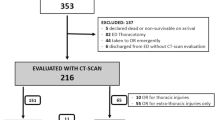Abstract
Study:
New generation spiral CT scanners permit multiple consecutive CT examinations on the same trauma patient in a short period of time. The purpose of this study was to evaluate the diagnostic role and therapeutic impact of routine spiral CT chest in multiply injured patients or patients with a suspicious mechanism of injury.
Patients and Methods:
This prospective study included 443 patients with blunt chest trauma. All patients underwent a spiral CT chest as part of their routine evaluation. Radiological interpretation of chest x-rays, CT scan findings, and changes in management plan guided by these findings were recorded.
Results:
The mechanism of injury was road traffic accidents in 422 patients (95.26%). Out of the 167 patients with normal chest radiograph, 136 (81.43%) were found to have an abnormality on chest CT. The management was changed in the form of additional investigations or unplanned intervention in 92 patients (20.76%). Additional investigations included transoesophageal echocardiography (n = 7), bronchoscopy (n = 13), transfer to higher center for aortography (n = 2). Intercostal tubes (n = 55), thoracotomies (n = 4), fixation of sternal fracture (n = 9), laparotomy (n = 1) and spinalfixation (n = 1) were performed following the CT scan.
Conclusion:
Although the incidence of significant injuries identified by the chest CT scan was low, it did prompt immediate intervention in a significant number of patients; some of them had potentially life-threatening injuries. Routine use of CT scanning is warranted in early evaluation of polytrauma patients or patients with severe blunt chest trauma.
Similar content being viewed by others
References
LoCicero J 3rd, Mattox KL. Epidemiology of chest trauma. Surg Clin North Am 1989;69:15–9.
Cohn SM. Pulmonary contusion: review of the clinical entity. J Trauma 1997;42:973–9.
Vécsei V, Arbes S, Aldrian S, Naul T. Chest injuries in polytrauma. Eur J Trauma 2005;31:239–43.
Khandhar SJ, Johnson SB, Calhoon JH. Overview of thoracic trauma in the United States. Thorac Surg Clin 2007;17:1–9.
Calhoon JH, Trinkle KJ. Pathophysiology of chest trauma. Chest Surg Clin N Am 1997;7:199–211.
Poletti PA, Wintermark M, Schnyder P, Becker CD. Traumatic injuries: the role of imaging inthemanagement of the polytrauma victim (conservative expectation). Eur Radiol 2002;12:969–78.
Costello P, Dupuy D, Ecker C, Tello R. Spiral CT of the thorax with small volumes of contrast material: a Comparative Study. Radiology 1992;183:663–6.
Baker SP, O’Neill B, Haddon W, et al. The Injury Severity Score: a method for describing patients with multiple injuries and evaluating emergency care. J Trauma 1974;14:187–96.
American College of Surgeons Committee on Trauma Advanced trauma life support course instructor manual. American College of Surgeons, Chicago, 1997.
Beck A, Bischoff M, Gebhard F. Apparative Diagnostik im Schockraum. Unfallchirurg 2004;107:862–70.
Braunschweig R, Wawro W. Integrierte Bildgebung bei Polytrauma. Trauma Berufskrankh 2005;7:207–13.
Mirvis SE, Shanmuganathan K, Buell J. Use of spiral computed tomography for the assessment of blunt trauma patients with potential aortic injury. J Trauma 1998;45:922–30.
Hessmann1 MH, Hofmann1 A, Kreitner K, Lott C, Rommens P. The benefit of multislice computed tomography in the emergency room management of polytraumatized patients. Eur J Trauma 2005;31:231–8.
Poletti PA, Mirvis SE, Shanmuganathan K, et al. Blunt abdominal trauma patients: can organ injury be excluded without performing computed tomography? J Trauma 2004;57:1072–81.
Marts B, Durham R, Shapiro M, et al. Computed tomography in the diagnosis of blunt thoracic injury. Am Surg 1994;168:688–92.
Poole GV, Morgan DB, Cranston PE, et al. Computed tomography in the management of blunt thoracic trauma. J Trauma 1993;35:296–300.
Trupka A, Waydhas C, Hallfeldt KK, et al. Value of thoracic computed tomography in the first assessment of severely injured patients with blunt chest trauma: results of a prospective study. J Trauma 1997;43:405–11.
Wilson D, Voystock JF, Sariego J. Role of computed tomography scan in evaluating the widened mediastinum. Am Surg 1994;60:421–3.
Sampson M, Colquhoun K, Hennessy N. Computed tomography whole body imaging in multi-trauma: 7 years experience. Clin Radiol 2006;61:365–9.
Exadaktylos AK, Sclabas G, Schmid SW, et al. Do we really need routine computed tomographic scanning in the primary evaluation of blunt chest trauma in patients with “normal” chest radiograph? J Trauma 2001;51:1173–6.
Guerrero-López F, Vázquez-Mata G, Alcázar-Romero PP, et al. Evaluation of the utility of computed tomography in the initial assessment of the critical care patient with chest trauma. Crit Care Med 2000;28:1370–5.
Blostein PA, Hodgman CG. Computed tomography of the chest in blunt thoracic trauma: results of a prospective study. J Trauma 1997;43:13–8.
Salim A, Sangthong B, Martin M, Brown C, Plurad D, Demetriades D. Whole body imaging in blunt multisystem trauma patients without obvious signs of injury: results of a prospective study. Arch Surg 2006;141:468–75.
Traub M, et al. The use of chest computed tomography versus chest X-ray in patients with major blunt trauma. Injury 2007;38:43–7.
Hayward R. VOMIT (victims of modern imaging technology) — an acronym for our times. BMJ 2003;326:1273.
Jindal A, Velmahos GC, Rofougaran R. Computed tomography for evaluation of mild to moderate pediatric trauma: are we overusing it?. World J Surg 2002;26:13–6.
Hadley J. Overutilization of imaging in the acute trauma setting. Abstract presented at 2004 annual meeting of the radiologic society of North America; 29 November 2004; Chicago, IL.
Kalra MK, Maher MM, Rizzo S, et al. Radiation exposure fromchest CT: issues and strategies. J Korean Med Sci 2004;19:159–66.
Brenner DJ, Elliston CD. Estimated radiation risks potentially associatedwith full-body CT screening. Radiology 2004;232:735–8.
Author information
Authors and Affiliations
Corresponding author
Rights and permissions
About this article
Cite this article
Hammad, AM.M., Regal, M.A. Is Routine Spiral CT-Chest Justified in Evaluation of the Major Blunt Trauma Patients?. Eur J Trauma Emerg Surg 35, 31–34 (2009). https://doi.org/10.1007/s00068-008-8025-9
Received:
Accepted:
Published:
Issue Date:
DOI: https://doi.org/10.1007/s00068-008-8025-9




